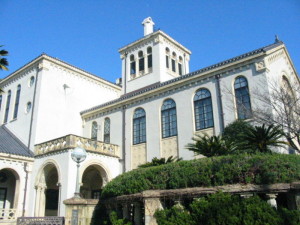
Story behind a church-like building near my house, possibly where my office will be later this year — This beautiful building — reputed to be one of the best architectural pieces of the period – now belongs to the Institute of Research of Humanities, Kyoto University. I was so impressed by its stone staircases and stained glass windows when I was asked to give a talk there on my work on the Yavanajātaka manuscript last year. It was built originally by the Shōwa government as the Institute of Oriental Culture 東方文化学院. When the Manchurian Empire lost the war to Japan, the latter demanded the Chinese a hefty indemnity. After the Manchurian Empire was overthrown, anti-Japanese sentiment continued to grow in China. With part of its funding coming from the indemnity, the establishment of the Institute in 1929 was conceived as a means to further collaboration between Chinese and Japanese academics. Regardless of its background and the colonialist agenda behind it, the institute produced generations of great scholars, including Yabuuti Kiyosi, whose works on Oriental Astronomy attracted worldwide scholarly attention. Last year I joined all the great teachers and disciples of Professor Yabuuti to celebrate his 14th memorial anniversary.
